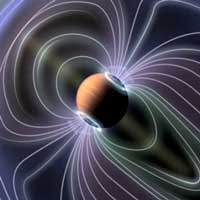| Dec 16, 2020 |
|
|
|
(Nanowerk News) By monitoring the cosmos with a radio telescope array, a Cornell University-led international team of scientists has detected radio bursts emanating from the constellation Boötes. The signal could be the first radio emission collected from a planet beyond our solar system.
|
|
The team, led by Cornell postdoctoral researcher Jake D. Turner, Philippe Zarka of the Observatoire de Paris Paris Sciences et Lettres University and Jean-Mathias Griessmeier of the Université dOrléans published their findings in the journal Astronomy & Astrophysics (“The search for radio emission from the exoplanetary systems 55 Cancri, upsilon Andromedae, and tau Boötis using LOFAR beam-formed observations”).
|
 |
| In this artistic rendering of the Tau Boötes b system, the lines representing the invisible magnetic field are shown protecting the hot Jupiter planet from solar wind. (Image: Jack Madden/Cornell University)
|
|
We present one of the first hints of detecting an exoplanet in the radio realm, Turner said. The signal is from the Tau Boötes system, which contains a binary star and an exoplanet. We make the case for an emission by the planet itself. From the strength and polarization of the radio signal and the planets magnetic field, it is compatible with theoretical predictions.
|
|
Among the co-authors is Turners postdoctoral advisor Ray Jayawardhana, the Harold Tanner Dean of the College of Arts and Sciences at Cornell, and a professor of astronomy.
|
|
If confirmed through follow-up observations, Jayawardhana said, this radio detection opens up a new window on exoplanets, giving us a novel way to examine alien worlds that are tens of light-years away.
|
|
Using the Low Frequency Array (LOFAR), a radio telescope in the Netherlands, Turner and his colleagues uncovered emission bursts from a star-system hosting a so-called hot Jupiter, a gaseous giant planet that is very close to its own sun. The group also observed other potential exoplanetary radio-emission candidates in the 55 Cancri (in the constellation Cancer) and Upsilon Andromedae systems. Only the Tau Boötes exoplanet system about 51 light-years away exhibited a significant radio signature, a unique potential window on the planets magnetic field.
|
|
Observing an exoplanets magnetic field helps astronomers decipher a planets interior and atmospheric properties, as well as the physics of star-planet interactions, said Turner, a member of Cornells Carl Sagan Institute.
|
|
Earths magnetic field protects it from solar wind dangers, keeping the planet habitable. The magnetic field of Earth-like exoplanets may contribute to their possible habitability, Turner said, by shielding their own atmospheres from solar wind and cosmic rays, and protecting the planet from atmospheric loss.
|
|
Two years ago, Turner and his colleagues examined the radio emission signature of Jupiter and scaled those emissions to mimic the possible signatures from a distant Jupiter-like exoplanet. Those results became the template for searching radio emission from exoplanets 40 to 100 light-years away.
|
|
After poring over nearly 100-hours of radio observations, the researchers were able to find the expected hot Jupiter signature in Tau Boötes. We learned from our own Jupiter what this kind of detection looks like. We went searching for it and we found it, Turner said.
|
|
The signature, though, is weak. There remains some uncertainty that the detected radio signal is from the planet. The need for follow-up observations is critical, he said.
|
|
Turner and his team have already begun a campaign using multiple radio telescopes to follow up on the signal from Tau Boötes.
|


